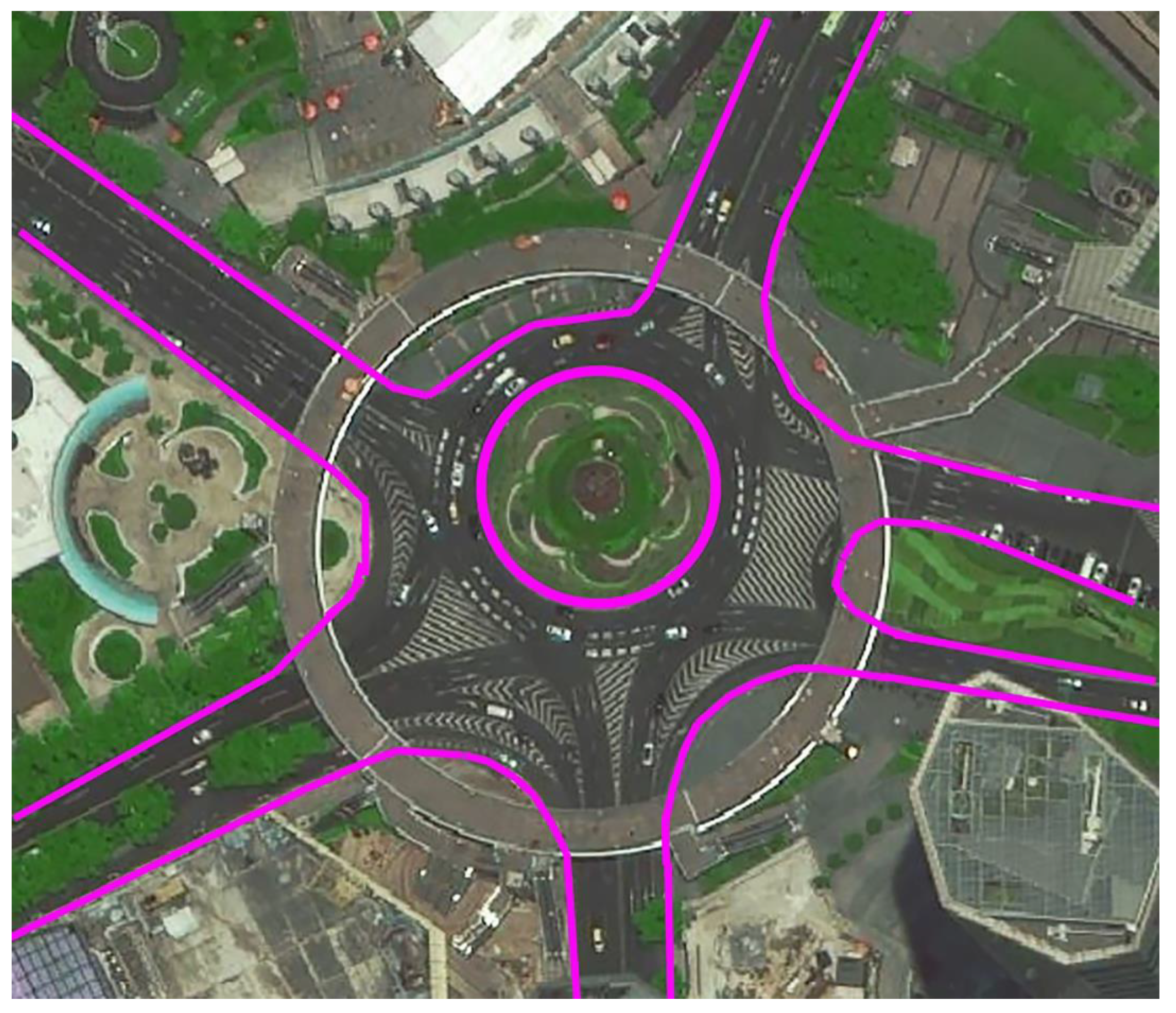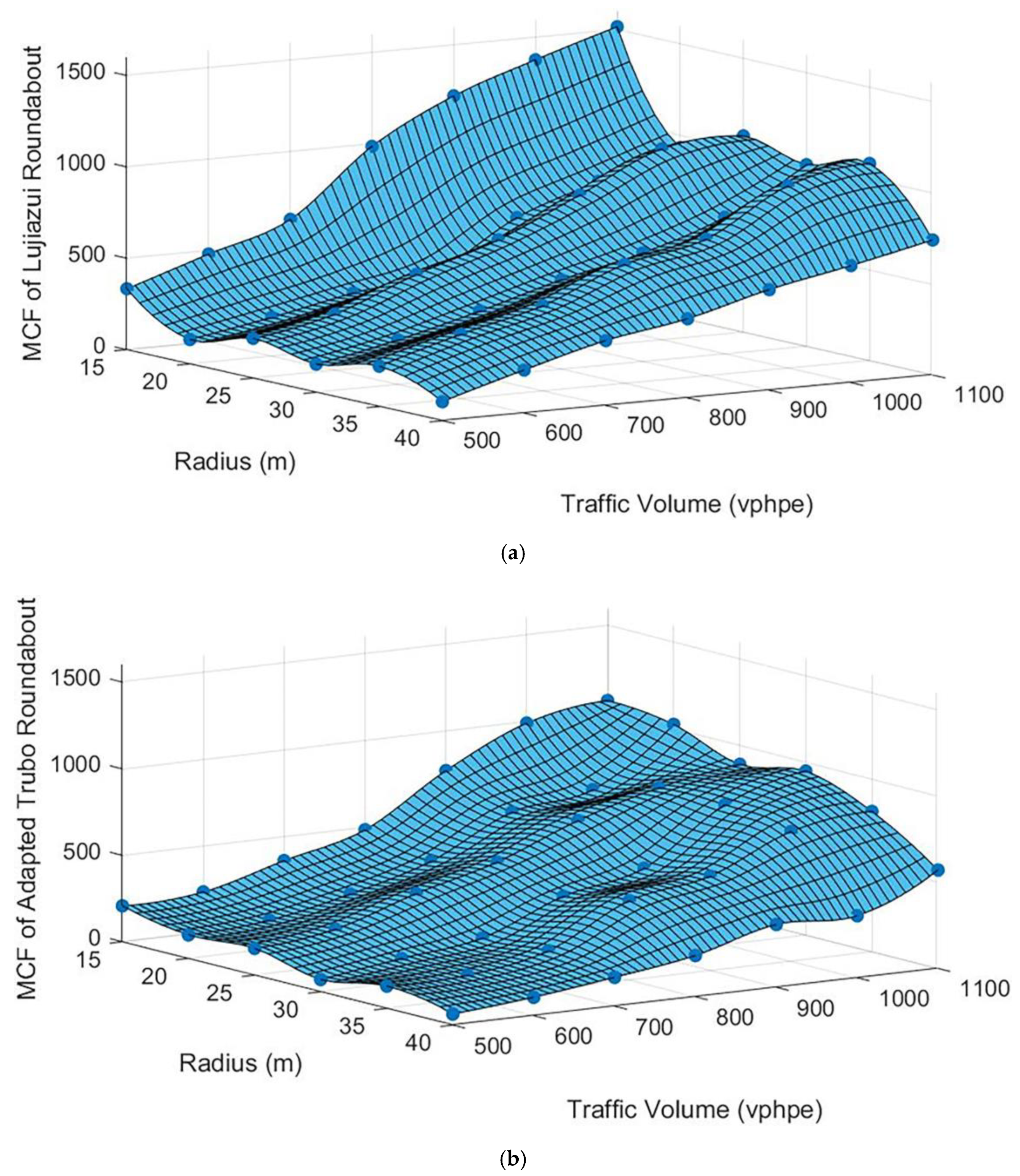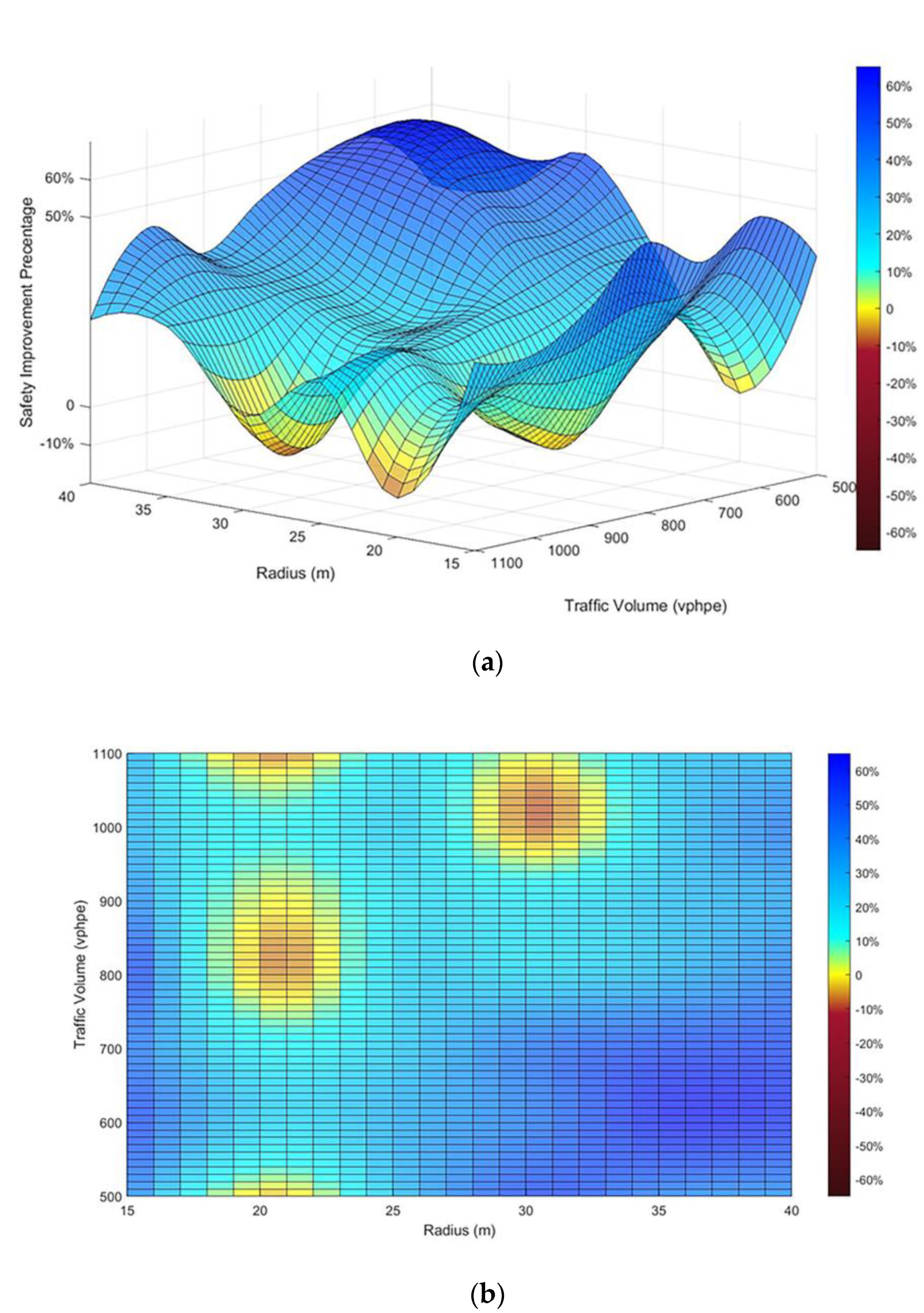Safety and Efficiency Analysis of Turbo Roundabout with Simulations Based on the Lujiazui Roundabout in Shanghai
Abstract
:1. Introduction
2. Literature Review
3. Methodology
3.1. Simulation and Data Extraction
3.2. Measure of Conflict Severity Index (CSI)
3.3. Calculating Modified Conflict Frequency (MCF)
4. Results
5. Conclusions
- A turbo design can improve the safety performance in most volume conditions. However, when the volume is 800–1100 vphpe with a 20–30 m radius, adapting the turbo design does not make an appreciable difference and can even cause performance degradation. For more beneficial safety improvements, the scenario with radii of 30–40 m and traffic volumes under 800 vphpe is recommended for applying the turbo design. It is important to leave enough space for each vehicle to avoid rear-end conflicts so that the safety benefit through channelization can be maximized.
- There is a limitation of the turbo design when considering transportation efficiency. High volumes with large radii could result in significant delays compared with designs without channelization. The delay mostly results from waiting for an acceptable gap at the entry. Therefore, we suggest designers avoid applying the turbo design on large roundabouts (>30 m) under high traffic volumes (>1000 vphpe).
- Disorderly lane changes at road sections of entry should be avoided in practice, as they may generate the underutilization of lane spaces and rear-end behavior due to traffic blocks. It is necessary to set rules to reduce the act of changing lanes across multiple channels, especially for HGVs and buses.
Author Contributions
Funding
Acknowledgments
Conflicts of Interest
References
- Fernandes, P.; Salamati, K.; Rouphail, N.; Coelho, M. The effect of a roundabout corridor’s design on selecting the optimal crosswalk location: A multi-objective impact analysis. Int. J. Sustain. Transp. 2017, 11, 206–220. [Google Scholar] [CrossRef]
- Tollazzi, T.; Rencelj, M. Comparative analyse of the two new alternative types of roundabouts—Turbo and flower roundabout. Balt. J. Road Bridg. Eng. 2014, 9, 164–170. [Google Scholar] [CrossRef]
- Montella, A. Identifying crash contributory factors at urban roundabouts and using association rules to explore their relationships to different crash types. Accid. Anal. Prev. 2011, 43, 1451–1463. [Google Scholar] [CrossRef]
- Guerrieri, M.; Corriere, F.; Rizzo, G.; Casto, B.L.; Scaccianoce, G. Improving the sustainability of transportation: Environmental and functional benefits of right turn by-pass lanes at roundabouts. Sustainability 2015, 7, 5838–5856. [Google Scholar] [CrossRef] [Green Version]
- Mauro, R.; Branco, F. Comparative analysis of compact multilane roundabouts and turbo-roundabouts. J. Transp. Eng. 2010, 136, 316–322. [Google Scholar] [CrossRef]
- Fortuijn, L.G. Turbo roundabouts: Design principles and safety performance. Transp. Res. Rec. 2009, 2096, 16–24. [Google Scholar] [CrossRef]
- Gallelli, V.; Vaiana, R.; Iuele, T. Comparison between simulated and experimental crossing speed profiles on roundabout with different geometric features. Procedia Soc. Behav. Sci. 2014, 111, 117–126. [Google Scholar] [CrossRef] [Green Version]
- Silva, A.B.; Seco, A. Trajectory deflection influence on the performance of roundabouts. In Proceedings of the European Transport Conference (ETC), Strasbourg, France, 3–5 October 2005. [Google Scholar]
- Silva, A.B.; Seco, A.; Silva, J. Characterization of trajectories adopted at roundabout crossings. In Proceedings of the European Transport Conference (ETC), Strasbourg, France, 18–20 September 2006. [Google Scholar]
- Praticò, F.; Vaiana, R.; Gallelli, V. Micro-simulation effectiveness in predicting operating speed profiles in a roundabout. Adv. Transp. Stud. 2015, 37, 5–14. [Google Scholar]
- Almoarawi, M.; Dabbour, E. Predicting operating speeds at urban multilane roundabouts in Abu Dhabi, United Arab Emirates. J. Adv. Transp. 2018, 2018, 1–10. [Google Scholar] [CrossRef]
- Izadi, A.; Mirzaiyan, D.; Rashidi, A.; Hosseini, M. Comparing traffic performances of turboroundabouts and conventional roundabout (case study). Turk. Online J. Des. Art. Commun. 2016, 6, 598–604. [Google Scholar] [CrossRef]
- Corriere, F.; Guerrieri, M. Performance analysis of basic turbo-roundabouts in urban context. Procedia Soc. Behav. Sci. 2012, 53, 622–632. [Google Scholar] [CrossRef] [Green Version]
- Guerrieri, M.; Ticali, D.; Corriere, F. Turbo roundabouts: Geometric design parameters and performance analysis. GSTF J. Comput. 2012, 2, 227–232. [Google Scholar]
- Giuffrè, O.; Guerrieri, M.; Granà, A. Evaluating capacity and efficiency of turbo-roundabouts. In Proceedings of the TRB 2009 Annual Meeting, Washington, DC, USA, 11–15 January 2009. [Google Scholar]
- Fortuijn, L.G. Turbo roundabouts: Estimation of capacity. Transp. Res. Rec. 2009, 2130, 83–92. [Google Scholar] [CrossRef]
- Brilon, W. Studies on roundabouts in Germany: Lessons learned. In Proceedings of the 3rd International TRB roundabout Conference, Carmel, IN, USA, 18–20 May 2011. [Google Scholar]
- Silva, A.B.; Santos, S.; Gaspar, M. Turbo-roundabout use and design. In Proceedings of the CITTA 6th Annual Conference on Planning Research, Responsive Transports for Smart Mobility, Coimbra, Portugal, 17 May 2013. [Google Scholar]
- Bulla, L.A.; Castro, W. Analysis and comparison between two-lane roundabouts and turbo roundabouts: Based on a road safety audit methodology and microsimulation—A case study in urban area. In Proceedings of the 3rd International Conference on Road Safety and Simulation, Indianapolis, IN, USA, 14–16 September 2011. [Google Scholar]
- CROW (Dutch Information and Technology Platform). Turborotondes (Turbo Roundabouts); CROW: Ede, The Netherlands, 2008. [Google Scholar]
- Ministry of Transport Republic of Slovenia. Krožna križišča (Roundabouts). Available online: https://www.gov.si/assets/organi-v-sestavi/DRSI/Dokumenti-DRSI/Tehnicne-specifikacije/TSC_03_341_2011_Krozna_krizisca.pdf (accessed on 10 September 2020).
- Serbian Authority for Roads, B. Priručnik za Projektovanje Puteva U Republici Srbiji, Dio 5.3 Kružne Raskrisnice (Manual for Road Design in Republic of Serbia, Part 5.3 Roundabouts); Putevi Srbije: Belgrade, Serbia, 2012. [Google Scholar]
- Džambas, T.; Ahac, S.; Dragčević, V. Geometric design of turbo roundabouts. Tech. Gaz. 2017, 24, 309–318. [Google Scholar] [CrossRef] [Green Version]
- Dirk de Baan. Verkeer, Verkeersveiligheid, Vorm. Available online: www.dirkdebaan.nl (accessed on 2 September 2020).
- Mahdalova, I.; Krivda, V.; Skvain, V. Influence of roundabout inscribed circle diameter to the traffic safety. In Proceedings of the 2nd International Conference on Civil, Architectural and Hydraulic Engineering (ICCAHE 2013), Zhuhai, China, 27–28 July 2013; pp. 1122–1125. [Google Scholar]
- Kim, S.; Choi, J. Safety analysis of roundabout designs based on geometric and speed characteristics. KSCE J. Civ. Eng. 2013, 17, 1446–1454. [Google Scholar] [CrossRef]
- Anjana, S.; Anjaneyulu, M.V.L.R. Development of safety performance measures for urban roundabouts in India. J. Transp. Eng. 2015, 141, 1. [Google Scholar] [CrossRef]
- Elhassy, Z.; Abou-Senna, H.; Shaaban, K.; Radwan, E. The implications of converting a high-volume multilane roundabout into a turbo roundabout. J. Adv. Transp. 2020, 2020, 1–12. [Google Scholar] [CrossRef]
- Gallelli, V.; Vaiana, R. Safety improvements by converting a standard roundabout with unbalanced flow distribution into an egg turbo roundabout: Simulation approach to a case study. Sustainability 2019, 11, 466. [Google Scholar] [CrossRef] [Green Version]
- Tak, S.; Kim, S.; Yeo, H. Development of a deceleration-based surrogate safety measure for rear-end collision risk. IEEE Trans. Intell. Transp. Syst. 2015, 16, 2435–2445. [Google Scholar] [CrossRef]
- Vasconcelos, L.; Silva, A.B.; Seco, A. Safety analysis of turbo-roundabouts using the SSAM technique. In Proceedings of the CITTA 6th Annual Conference on Planning Research, Coimbra, Portugal, 17 May 2013. [Google Scholar]
- Al-Ghandour, M.N.; Schroeder, B.J.; Williams, B.M.; Rasdorf, W.J. Conflict models for single-lane roundabout slip lanes from microsimulation: Development and validation. Transp. Res. Rec. 2011, 2236, 92–101. [Google Scholar] [CrossRef]
- Souleyrette, R.; Hochstein, J. Development of a Conflict Analysis Methodology Using SSAM (No. InTrans Project 10-376); The Institute for Transportation, Iowa State University: Ames, IA, USA, 2012. [Google Scholar]
- Gettman, D.; Pu, L.; Sayed, T.; Shelby, S.; Siemens, I. Surrogate Safety Assessment Model and Validation; United States Federal Highway Administration, Office of Safety Research and Development: McLean, VA, USA, 2008; FHWA-HRT-08-051. [Google Scholar]
- Guo, Y.; Essa, M.; Sayed, T.; Haque, M.M.; Washington, S. A comparison between simulated and field-measured conflicts for safety assessment of signalized intersections in Australia. Transp. Res. Pt. C-Emerg. Technol. 2019, 101, 96–110. [Google Scholar] [CrossRef]
- Vaiana, R.; Gallelli, V.; Iuele, T. Methodological approach for evaluation of roundabout performances through microsimulation. Appl. Mech. Mater. 2012, 253–255, 1956–1966. [Google Scholar] [CrossRef]
- Praticò, F.; Vaiana, R.; Gallelli, V. Transport and traffic management by micro simulation models: Operational use and performance of roundabouts. In Proceedings of the 18th International Conference on Urban Transport and the Environment (UT’12), A Coruna, Spain, 14–16 May 2012; pp. 383–394. [Google Scholar]
- Trueblood, M.; Dale, J. Simulating roundabouts with VISSIM. In Proceedings of the 2nd Urban Street Symposium: Uptown, Downtown, or Small Town: Designing Urban Streets That Work, Anaheim, CA, USA, 28–30 July 2003. [Google Scholar]
- Gagnon, C.; Sadek, A.W.; Touchette, A.; Smith, M. Calibration potential of common analytical and microsimulation roundabout models: New England case study. Transp. Res. Rec. 2008, 2071, 77–86. [Google Scholar] [CrossRef] [Green Version]
- Bared, J.; Edara, P.K. Simulated capacity of roundabouts and impact of roundabout within a progressed signalized road. In Proceedings of the TRB National Roundabout Conference, Vail, CO, USA, 22–25 May 2005. [Google Scholar]
- Elias, A. Roundabout Modeling in CORSIM. Master‘s Thesis, University of Florida, Gainesville, FL, USA, 2009. [Google Scholar]
- Gallelli, V.; Iuele, T.; Vaiana, R.; Vitale, A. Investigating the transferability of calibrated microsimulation parameters for operational performance analysis in roundabouts. J. Adv. Transp. 2017, 2017, 1–10. [Google Scholar]
- Vaiana, R.; Gallelli, V.; Iuele, T. Sensitivity analysis in traffic microscopic simulation model for roundabouts. Balt. J. Road Bridg. Eng. 2013, 8, 174–183. [Google Scholar] [CrossRef]
- Guido, G.; Vitale, A.; Saccomanno, F.; Gallelli, V. Sensitivity of simulated vehicle tracking profiles for input into safety performance analysis. Adv. Transp. Stud. 2016, 2, 65–74. [Google Scholar]
- Huang, F.; Liu, P.; Yu, H.; Wang, W. Identifying if VISSIM simulation model and SSAM provide reasonable estimates for field measured traffic conflicts at signalized intersections. Accid. Anal. Prev. 2013, 50, 1014–1024. [Google Scholar] [CrossRef]
- Vasconcelos, L.; Silva, A.B.; Seco, Á.M.; Fernandes, P.; Coelho, M.C. Turboroundabouts: Multicriterion assessment of intersection capacity, safety, and emissions. Transp. Res. Rec. 2014, 2402, 28–37. [Google Scholar] [CrossRef] [Green Version]
- Gettman, D.; Head, L. Surrogate safety measures from traffic simulation models. Transp. Res. Rec. 2003, 1840, 104–115. [Google Scholar] [CrossRef] [Green Version]









| From | To | Distance (m) | Travel Time (sec) | ||
|---|---|---|---|---|---|
| Vissim | Field Runs | % Diff. | |||
| Entry 1 | Entry 2 | 36.36 | 9.04 | 9.33 | −3.10% |
| Entry 2 | Entry 3 | 36.15 | 8.87 | 8.56 | +3.60% |
| Entry 3 | Entry 4 | 51.33 | 6.55 | 6.25 | +4.80% |
| Yielding Principle | |
| Minimum time gap | 3.0 L |
| Minimum space gap | 5.0 m |
| Maximum vehicle velocity | 30.0 km/h |
| Deceleration Area (α—Deceleration Rate) | |
| Car (inside roundabout) | 12 (α = 2) km/h |
| HGV/bus (inside roundabout) | 10 (α = 2) km/h |
| Car (before entering) | 15 (α = 2) km/h |
| HGV/bus (before entering) | 12 (α = 2) km/h |
| CSI (85th Lower Percentile Value) | CSI’ (Standardized) | |
|---|---|---|
| Rear-end conflict | 0.09 | 1 |
| Lane-change conflict | 0.1495 | 1.66 |
| Crossing conflict | 0.2935 | 3.26 |
| Type | Adapted Turbo Roundabout | Lujiazui Roundabout | |||||
|---|---|---|---|---|---|---|---|
| Volume (vphpe) | Crossing | Rear-End | Lane-Change | Crossing | Rear-End | Lane-Change | |
| 500 | 20 | 3 | 52 | 12 | 34 | 87 | |
| 600 | 23 | 13 | 74 | 18 | 52 | 119 | |
| 700 | 45 | 24 | 115 | 22 | 135 | 167 | |
| 800 | 41 | 65 | 175 | 25 | 178 | 224 | |
| 900 | 45 | 126 | 242 | 20 | 302 | 282 | |
| 1000 | 58 | 184 | 263 | 32 | 330 | 368 | |
| 1100 | 47 | 251 | 293 | 23 | 396 | 364 | |
© 2020 by the authors. Licensee MDPI, Basel, Switzerland. This article is an open access article distributed under the terms and conditions of the Creative Commons Attribution (CC BY) license (http://creativecommons.org/licenses/by/4.0/).
Share and Cite
Liu, Q.; Deng, J.; Shen, Y.; Wang, W.; Zhang, Z.; Lu, L. Safety and Efficiency Analysis of Turbo Roundabout with Simulations Based on the Lujiazui Roundabout in Shanghai. Sustainability 2020, 12, 7479. https://doi.org/10.3390/su12187479
Liu Q, Deng J, Shen Y, Wang W, Zhang Z, Lu L. Safety and Efficiency Analysis of Turbo Roundabout with Simulations Based on the Lujiazui Roundabout in Shanghai. Sustainability. 2020; 12(18):7479. https://doi.org/10.3390/su12187479
Chicago/Turabian StyleLiu, Qiujia, Jiali Deng, Yifan Shen, Wenxin Wang, Zhan Zhang, and Linjun Lu. 2020. "Safety and Efficiency Analysis of Turbo Roundabout with Simulations Based on the Lujiazui Roundabout in Shanghai" Sustainability 12, no. 18: 7479. https://doi.org/10.3390/su12187479





